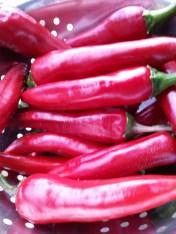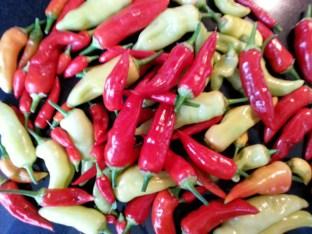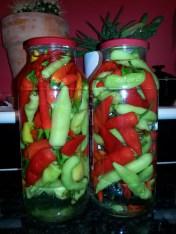A little chilli update for the month of October:
I had no idea that it had been so long since my last update which was in August. How time flies!
Well as my chilli season comes to and end and I’ve just got a few pods left to harvest I have to say it’s been a jolly good year for chilli growing in the garden.
Aside from a couple of storms, which caught some of the plants off guard, the rest have grown strong and produced flowers and bountiful pods.
At the end of last month I harvested most of the pods. Not only did I manage to fill up two large vinegar jars with pods for pickling, but had fresh ones to give away to friends and family. On top of that I’ve also got a line of cayenne peppers hanging up to dry.
The pods left over are the ones I’ve really been waiting for – the Naga’s!
I hoping to make my own hot chilli sauce with those.




Review of the year:
As the growing season ends there are a few things I’ve learnt around growing chillies this year:
- The grow-house I bought from the local pound shop was perfect for growing chillies. Well worth £7.99 because over winter I can now use it to cover one of the beds for winter salads.
- Seaweed is the preferred food for growing chillies. Even tomato feed with extra seaweed can make all the difference.
- Starting off the seeds early in the year is a good idea but unless you’ve got the specialist equipment like heat pads and lighting there really is no point sowing until end of February, beginning of March (with a heated propagator). Once seeds have germinated as long as you can keep them in a warm, light room until May then they will be fine.
- Good air circulation around the plants is key to ensuring better pollination and keeping down greenfly
- The wool pellets I bought earlier in the year were great for keeping the slug and snail population down. While it’s difficult to completely eradicate these pests who find it easy to climb up anything to reach the chilli plants it did at slow the destruction right down.
- Having said that, even though some of the plants were munched on, they still did well and went on to produce flowers and pods. Sometimes we worry that the plant doesn’t look nice enough with holes in the leaves but actually it worked out okay!
Moving on
I’ve decided to reduce the number of plants I grow next year. Having learnt that I can’t grow the more specialist varieties of chillies it means I can concentrate on those that can be grown well in my part of the world, varieties which can be used for cooking or preserving over winter.
In the world of chilli growing I think I’ve gone as far as I can with it. So next season chilli growing will blend in to become part of the rest of the garden’s growing space, rather than a dedicated crop on it’s own. I’ve thoroughly enjoyed trialing chilli varieties and growing the plants, and I’ve learnt loads over the past five years. I’d recommend anyone having a go at growing them.
Chilli plants that can be grown in the UK without extra heat and light include Jalapeno’s, Cayenne, any of the varieties which state annumm on the seed packets. Rather than those varieties that put all their effort into making the plant for years of repeated pods like the chinense (habaneros) or pubescens (rocoto) varieties, as well as heritage types too. That’s not to say you can’t grow the other varieties, indeed it’s possible, but just that these varieties take longer to look after and need more time (and in some instances extra equipment) given to them.
Let me know how you’re getting on with your chilli plants and please share any photo’s you have.
